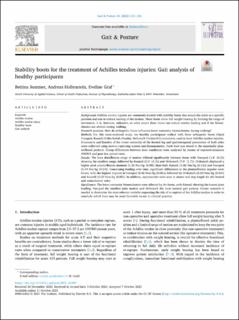Please use this identifier to cite or link to this item:
https://doi.org/10.21256/zhaw-23311Full metadata record
| DC Field | Value | Language |
|---|---|---|
| dc.contributor.author | Sommer, Bettina | - |
| dc.contributor.author | Hollenstein, Andreas | - |
| dc.contributor.author | Graf, Eveline | - |
| dc.date.accessioned | 2021-10-15T12:41:50Z | - |
| dc.date.available | 2021-10-15T12:41:50Z | - |
| dc.date.issued | 2021 | - |
| dc.identifier.issn | 0966-6362 | de_CH |
| dc.identifier.issn | 1879-2219 | de_CH |
| dc.identifier.uri | https://digitalcollection.zhaw.ch/handle/11475/23311 | - |
| dc.description.abstract | Background: Achilles tendon injuries are commonly treated with stability boots that secure the ankle at a specific position and aim to reduce loading of the tendon. These boots allow full weight bearing by limiting the range of movement. It is, however, unknown, to what extent these boots can reduce tendon loading and if the biomechanics are altered during walking. Research question: How do orthopedic boots influence lower extremity biomechanics during walking? Methods: For this cross-sectional study, ten healthy participants walked with three orthopedic boots (Oped Vacoped, Kuenzli Ortho Rehab Absolut, Orthotech Variostabil) commonly used to treat Achilles tendon injuries. Kinematics and kinetics of the lower extremity of the booted leg and spatiotemporal parameters of both sides were collected using motion-capturing system and dynamometry. Each boot was tested in the maximally plantarflexed position. Group differences between boot conditions were analyzed by means of repeated-measures ANOVA and post-hoc paired t-test. Results: The boot dorsiflexion range of motion differed significantly between boots with Vacoped (1.8 ° (0.3)) showing the smallest range, followed by Kuenzli (5.0 ° (1.3)) and Orthotech (7.9 ° (1.7)). Orthotech displayed a higher peak plantarflexion moment (1.36 Nm/kg (0.09)) than both Kuenzli (1.06 Nm/kg (0.12)) and Vacoped (1.04 Nm/kg (0.14)). Concerning loading over time, significant differences in the plantarflexion impulse were found, with the highest impulse in Vacoped (0.42 Nms/kg (0.06)), followed by Orthotech (0.29 Nms/kg (0.03)) and Kuenzli (0.25 Nms/kg (0.05)). In addition, asymmetries were seen in stance and step length for the booted and contralateral sides. Significance: The lower extremity biomechanics were affected by the boots, with Kuenzli showing the lowest joint loading, Vacoped the smallest joint motion and Orthotech the most natural gait pattern. Future research is needed to determine the most relevant variable expressing the risk of re-rupture of the Achilles tendon in order to conclude which boot may be most favorable to use in clinical practice. | de_CH |
| dc.language.iso | en | de_CH |
| dc.publisher | Elsevier | de_CH |
| dc.relation.ispartof | Gait & Posture | de_CH |
| dc.rights | http://creativecommons.org/licenses/by/4.0/ | de_CH |
| dc.subject | Achilles tendon | de_CH |
| dc.subject | Achilles tendon injury | de_CH |
| dc.subject | Stability boot | de_CH |
| dc.subject | Gait analysis | de_CH |
| dc.subject.ddc | 610: Medizin und Gesundheit | de_CH |
| dc.title | Stability boots for the treatment of Achilles tendon injuries : gait analysis of healthy participants | de_CH |
| dc.type | Beitrag in wissenschaftlicher Zeitschrift | de_CH |
| dcterms.type | Text | de_CH |
| zhaw.departement | Gesundheit | de_CH |
| zhaw.organisationalunit | Institut für Physiotherapie (IPT) | de_CH |
| dc.identifier.doi | 10.1016/j.gaitpost.2021.10.009 | de_CH |
| dc.identifier.doi | 10.21256/zhaw-23311 | - |
| zhaw.funding.eu | No | de_CH |
| zhaw.originated.zhaw | Yes | de_CH |
| zhaw.pages.end | 136 | de_CH |
| zhaw.pages.start | 131 | de_CH |
| zhaw.publication.status | publishedVersion | de_CH |
| zhaw.volume | 91 | de_CH |
| zhaw.publication.review | Peer review (Publikation) | de_CH |
| zhaw.webfeed | G: IPT: Intervention | de_CH |
| zhaw.funding.zhaw | Künzli Rehab Absolut | de_CH |
| zhaw.author.additional | No | de_CH |
| zhaw.display.portrait | Yes | de_CH |
| Appears in collections: | Publikationen Gesundheit | |
Files in This Item:
| File | Description | Size | Format | |
|---|---|---|---|---|
| 2021_Sommer-etal_Stability-boots-Achilles-tendon-injuries.pdf | 1.13 MB | Adobe PDF |  View/Open |
Show simple item record
Sommer, B., Hollenstein, A., & Graf, E. (2021). Stability boots for the treatment of Achilles tendon injuries : gait analysis of healthy participants. Gait & Posture, 91, 131–136. https://doi.org/10.1016/j.gaitpost.2021.10.009
Sommer, B., Hollenstein, A. and Graf, E. (2021) ‘Stability boots for the treatment of Achilles tendon injuries : gait analysis of healthy participants’, Gait & Posture, 91, pp. 131–136. Available at: https://doi.org/10.1016/j.gaitpost.2021.10.009.
B. Sommer, A. Hollenstein, and E. Graf, “Stability boots for the treatment of Achilles tendon injuries : gait analysis of healthy participants,” Gait & Posture, vol. 91, pp. 131–136, 2021, doi: 10.1016/j.gaitpost.2021.10.009.
SOMMER, Bettina, Andreas HOLLENSTEIN und Eveline GRAF, 2021. Stability boots for the treatment of Achilles tendon injuries : gait analysis of healthy participants. Gait & Posture. 2021. Bd. 91, S. 131–136. DOI 10.1016/j.gaitpost.2021.10.009
Sommer, Bettina, Andreas Hollenstein, and Eveline Graf. 2021. “Stability Boots for the Treatment of Achilles Tendon Injuries : Gait Analysis of Healthy Participants.” Gait & Posture 91: 131–36. https://doi.org/10.1016/j.gaitpost.2021.10.009.
Sommer, Bettina, et al. “Stability Boots for the Treatment of Achilles Tendon Injuries : Gait Analysis of Healthy Participants.” Gait & Posture, vol. 91, 2021, pp. 131–36, https://doi.org/10.1016/j.gaitpost.2021.10.009.
Items in DSpace are protected by copyright, with all rights reserved, unless otherwise indicated.